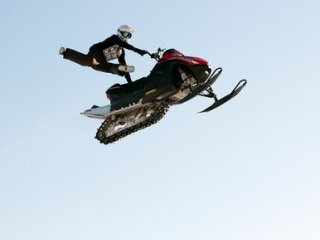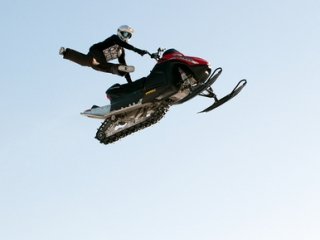 Freestyle motocross has become a staple of extreme sports competitions. I’ve come to accept that a select group of highly talented and mildly insane individuals are capable of hurling their motorcycles through the air, flipping backwards, doing a fancy body maneuver and landing on two wheels. Then one day, I flipped the channel and saw all of this hullaballoo happening on a snowmobile. I was mesmerized. Who in their right mind, I thought, would think it was reasonable to launch a snowmobile off of a man made ramp, flip it over and land shiny side up? Apparently the same kind of people who partake in motocross, but who really like snow.
Freestyle motocross has become a staple of extreme sports competitions. I’ve come to accept that a select group of highly talented and mildly insane individuals are capable of hurling their motorcycles through the air, flipping backwards, doing a fancy body maneuver and landing on two wheels. Then one day, I flipped the channel and saw all of this hullaballoo happening on a snowmobile. I was mesmerized. Who in their right mind, I thought, would think it was reasonable to launch a snowmobile off of a man made ramp, flip it over and land shiny side up? Apparently the same kind of people who partake in motocross, but who really like snow.
Since the first practical snowmobile was released in the mid 1950’s by the company that would later become Polaris, the sport, and the machines have come a long way. As the size and weight of snowmobiles decreased, the maneuverability of the machines was pushed to the limit by innovative, snow-loving thrill seekers.
Over the past decade “Extreme Snowmobiling” has begun to gain recognition as a legitimate sector of snowmobile recreation. While high flying tricks and daredevil stunts are often the first recollection that most people have of the sport, high level backcountry riding is also considered a form of extreme snowmobiling that offers accessibility to a larger sector of the snowmobile community.
Aerial tricks of the sport are performed off of man-made ramps similar to those used in motocross, or ramps built from snow and natural features in backcountry areas. Competitions are often held in popular winter resort destinations including Jackson Hole, Wyoming and Vail, Colorado. However, snow is a finicky medium. When Mother Nature doesn’t play along, competitions are often held in set courses on a soft dirt or grass surface. The backcountry arm of this extreme sport involves riding uncharted territory in snow laden areas throughout North America.
Like many backcountry activities, however, extreme snowmobiling is not without controversy. Safety has become a major concern for many, as extreme hill climbing with sleds can cause a high avalanche risk when the proper precautions are ignored. A 2010 extreme competition in British Columbia left three people dead and more than thirty with serious injuries after new snow layered on top of ice broke free. The subsequent avalanche occurred in the midst of the annual competition after avalanche warnings were overlooked. Concerns have also been raised by environmental activists regarding the impact of the sport on pristine backcountry territory.
In the long run, despite the risks, it seems that extreme snowmobiling has established itself as an extreme sport that is here to stay. In order to ensure the viability of the sport and safety of riders, it’s of the utmost importance that snowmobile enthusiasts practice extreme riding responsibly while keeping mind of safety and respect for the land on which they ride. And although I know that it will never be me up there, flying through the crisp January air, I sure do have fun watching those other loons do it.








